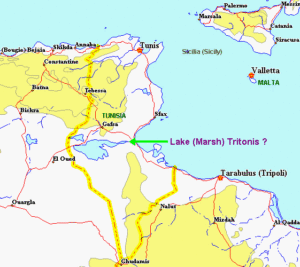Cindy Clendenon
Geomythology *
Geomythology is a word coined by the geologist Dorothy Vitaliano in her 1973 book Legends of the Earth[306] to describe “the study of alleged references to geological events in mythology.”
Since then, the term has gradually gained widespread acceptance including an extensive entry in the Encyclopedia of Geology(a). The status of the subject has been consolidated by its inclusion as a separate course at the University of Puget Sound(b). Apart from Vitaliano other writers, such as Gerald Wells, have applied geomythology to the study of Atlantis without necessarily using the term(e). I should point out that mythology is also used to transmit details of spectacular astronomical events as well as more mundane political or military exploits.
Further support for the young discipline came with the publication of Myth and Geology by the Geological Society of London in 2007, with Luigi Piccardi & Bruce Masse as editors[1541].
Patrick Nunn, an Australian geologist, who, although an Atlantis sceptic has begun to reconsider the possibility of ancient myths containing important geological information(c). A 2017 paper by Nunn gave examples of where the application of geomythology has offered solutions to some old mysteries(g).
Also in May 2021, the BBC offered a lengthy paper, by Mark Piesing, on the development of geomythology in recent years and how it may have implications for our planet’s future(f).
>Professor Timothy John Burbery of Marshall University supports the linkage of the eruption of Thera with the Titanomachy in an August 2021 article(c). He has recently published his new book, Geomythology: How Common Stories Reflect Earth Events [1873].<
Cindy Clendenon, presumably inspired by Vitaliano, has launched a related new specialised field of study, which she has named ‘hydromythology’ in her 2009 book, Hydromythology and the Ancient Greek World [0801], a review of which is available online(d).
(a) Wayback Machine (archive.org) *
(d) https://web.archive.org/web/20190927120932/https://bmcr.brynmawr.edu/2010/2010-08-65.html
(e) https://web.archive.org/web/20160527131112/https://www.wrl-inc.org/tag/geomythology
(f) The myths that hint at past disasters – BBC Future
Vitaliano, Dorothy B.
 Dorothy B. Vitaliano (1916-2008) was a geologist who published Legends of the Earth in 1973[0306] in which she discussed how catastrophic seismic or volcanic events were retained for posterity in the legends of the peoples who experienced them. She invented the term ‘geomythology’ to describe what she considered to be a distinct field of study.
Dorothy B. Vitaliano (1916-2008) was a geologist who published Legends of the Earth in 1973[0306] in which she discussed how catastrophic seismic or volcanic events were retained for posterity in the legends of the peoples who experienced them. She invented the term ‘geomythology’ to describe what she considered to be a distinct field of study.
Probably inspired by Vitaliano, Cindy Clendenon has promoted a new related field of study(c) that she calls ‘hydromythology’[0801].
Vitaliano’s book included a chapter on Atlantis in which she expresses her opinion that there is nowhere in the Atlantic Ocean that Atlantis could have existed. Understandably, sceptics of an Atlantic Atlantis seized upon this statement, while those that adhere to the idea that it had been a large island in that ocean were understandably dismayed. Vitaliano also discussed the biblical Plagues of Egypt and their connection with the eruption of Thera in the second millennium BC.
Dorothy’s husband, Charles J. Vitaliano (1910-2000) was also a professor of geology and together they pursued the study of major geological events and their effect on ancient cultures.
There are two of Vitaliano’s papers that are available online(a)(b)as well as some sample pages from her book(d) and a short review (e).
>>In 2024, Joseph O’Donoghue published the first two volumes [2100/1] of an eight-part series titled The Legend of Atlantis and the Science of Geology. He has devoted a number of chapters of Volume One to a criticism of Vitaliano’s concept of geomythology.<<
(a) https://www.scribd.com/doc/88638242/Geo-Mythology
(b) https://www.scribd.com/doc/88638136/Atlantis-a-Review-Essay
(d) https://www.bmblebeebbooks.net/book_pages/1174.html (link broken)
(e) https://digicoll.library.wisc.edu/cgi-bin/WI/WI-idx?type=div&did=WI.v20i4.i0016&isize=text
Lake Tritonis *
Lake Tritonis is frequently referred to by the classical writers. Ian Wilson refers to Scylax of Caryanda as having “specifically described Lake Tritonis extending in his time over an area of 2,300 km2.“ He also cites Herodotus as confirming it as still partly extant in his time, a century later, describing it as a ‘great lagoon’, with a ‘large river’ (the Triton) flowing into it.[185.185]
Lake Tritonis was considered the birthplace of Athene, the Greek Goddess of Wisdom, after whom Athens is named. The exact location of the lake is disputed but there is some consensus that the salty marshes or chotts of central Tunisia and North-East Algeria are the most likely candidates. It appears that these marshes originally formed a large inland sea connected to the Mediterranean but due to seismic activity in the area were cut off from the sea. Diodorus Siculus records this event in his third book.
I should also mention that Lake Tritonis along with the Greek island of Lemnos and the river Thermodon in northern Turkey, now known as Terme Çay, have all been associated with the Amazons(d).
Edward Herbert Bunbury, a former British MP, included a chapter(a) on Lake Tritonis in his 1879 book on the history of ancient geography [1531.v1.316]+.
geography [1531.v1.316]+.
In 1883, Edward Dumergue published[659]+ a brief study of the Tunisian chotts, which he concluded were the remnants of an ancient inland sea that had been connected to the Mediterranean Sea at the Gulf of Gabes.
Lucile Taylor Hansen in The Ancient Atlantic[572], has included a speculative map taken from Reader’s Digest showing Lake Tritonis, around 11.000 BC, as a megalake covering much of today’s Sahara, with the Ahaggar Mountains turned into an island. Atlantis is shown to the west in the Atlantic.
In 1967 Egerton Sykes published a paper entitled The Sahara Inland Sea in which he describes a vast inland sea of ‘remarkable proportions’ and “is attested not only by classical references but also by the fact that beneath most of it lies a layer of brackish water ranging from 200 to 500 feet below the ground. The various oases are believed to be located on patches where the depth is only about 50 feet, conducive to plant survival. The climatic change seems to have happened quite recently, around 5000 BC. B.C., since the classics contain numerous references to its [the inland sea] existence.”(e)
I should mention here that the Atlantis theory of George Sarantitis is entirely dependent on extensive inland waterways including the chotts of Tunisia and Algeria as well as a number of other large lakes and rivers in what is now the Sahara.
In modern times, Alberto Arecchi has taken the idea further[079] and suggested that the inland sea, where the chotts are now, was the original ‘Atlantic Sea’ and that the city of Atlantis was situated on an extended landmass to the east of Tunisia and connected to Sicily due to a lower sea level. Arecchi’s identification of the chotts with Lake Tritonis has now been adopted by Lu Paradise in a May 2015 blog(c). The Qattara Depression of Northern Egypt also contains a series of salt lakes and marshes and is believed by others to have been Lake Tritonis.
Cindy Clendenon is the author of a book [801.397] on hydromythology in which she concludes that “the now-extinct Lake Tritonis once was a Cyrenaican lagoon-sabkha complex near today’s Sabkha Ghuzayyil and Marsa Brega, Libya”(b), not in Tunisia! Clyde Winters also placed Lake Tritonis in Libya(f).
[659]+ https://archive.org/details/chottstunisorgr01dumegoog
[1531.v1.316]+ https://archive.org/stream/historyofancient01bunb#page/n6/mode/1up/search/Tritonis Vol.1
(a) Lake Tritonis – Jason and the Argonauts (archive.org) *
(b) https://www.abebooks.com/9780981842103/Hydromythology-Ancient-Greek-World-Earth-0981842100/plp
(d) https://www.myrine.at/Amazons/mobilIndex.html
(e) The Saharan Inland Sea – Atlantisforschung.de (atlantisforschung-de.translate.goog)
(f) https://africanbloodsiblings.wordpress.com/2013/11/21/fertile-african-crescent-by-clyde-winters/
